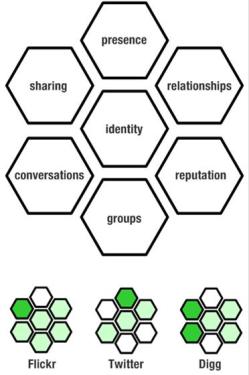David Warlick was live blogging in David Gratton’s session, where he drew an interesting picture from Gene Smith of the features of social networks. David said:

“The Internet has been about community all along, Usenet, forums, chat rooms, geocities Home page and webring and e-mail. To say that things have changed is wrong. What’s changed is that the barriers are gone. What’s changed is the syndication process — RSS.”
Interestingly, I had just commented to Jon Becker in his blog post about “How To Digitally Supplement a PLC” that the key was using the power of RSS to bring the conversation to the faculty.
David went on to note that social networks are all different. Using Gene Smith’s diagram, they are all about:

- Identity,
- Presence,
- Relationships,
- Conversations,
- Groups,
- Reputation, and
- Sharing
I like this breakdown and am adding to David’s comments. Linkedin and Plaxo are all about identity. Wither and Bebo are about presence. Relationships are in many of the tools and conversations such as MySpace, Facebook, and Ning. Twitter is entirely about conversations (and can be addictive!). Groups are a major part of Flickr, Ning, Facebook and Basecamp. Reputation comes out of forums and followings – the number of posts, replies and ranking. Delicious and Diigo are built on sharing.
David asked how this might apply to education. He noted that students and teachers can ask questions and give directions, with other students and teachers responding. The whole thing turns into content, driving discussion which builds more content.
To me, the key lies in the learning outcomes. If one goes back to Chickering and Gamson’s Seven Principles of Good Practice, one sees connections between the seven principles and Smith’s building blocks:
Good practice in undergraduate education:
1. Encourages student-faculty contact.
– Tools that encourage relationships and communication work here, including Twitter, Facebook, and even learning management systems such as Blackboard or Desire2Learn. The key is the two-way routine contact.
2. Encourages cooperation among students.
– Groups and sharing help in the collaborative efforts needed for cooperation. Setting up a Ning site can be a useful way to not only build cooperation within a class, but with the global community as well.
3. Encourages active learning.
– The Read-Write web is not a passive environment. As students and teachers learn together through exploration of the web resources, they build knowledge and capacity to effectively compete in global markets.
4. Gives prompt feedback.
– The Read-Write web not only offers 24/7 connectivity, but fosters peer-review and formative assessment. Through the relationships build online, trust is developed and students learn to analyze and critique their own work and that of their peers, driving quality up.
5. Emphasizes time on task.
– The good news (and the bad) is that these technologies and processes expand the time for student work beyond the simple dictates of the course catalog. One of the challenges might become helping students find balance in this always on world, as Jeff Nugent noted last night.
6. Communicates high expectations.
– Through identity, presence, and reputation, faculty can model expected behavior and drive expectations. I have always found that students rise to the expectations set no matter how high, and the new social media gives students the tools to achieve those high expectations.
7. Respects diverse talents and ways of learning.
– One of the positive aspects of social media is the exposure students receive to other cultures and other ways of thinking. This in turn can help drive their creativity and desire to explore new avenues outside the rigid curricula in place in most schools.
Much of the literature seems to paint social media with the same broad brush. David Warlick, David Gratton, and Gene Smith are helping me see the many facets that make up social media, and the multiple opportunities these open for students.
2 thoughts on “The Facets of Social Networks”